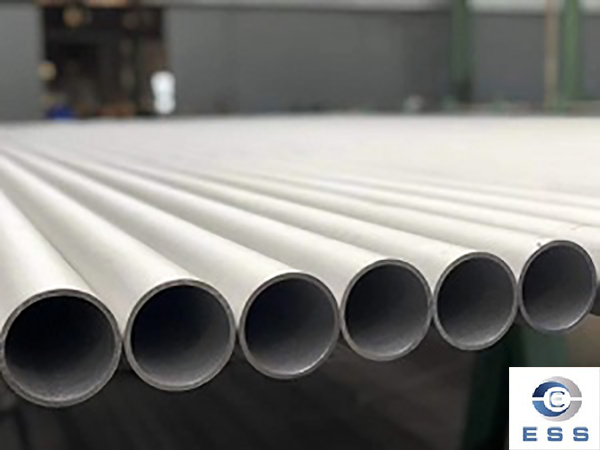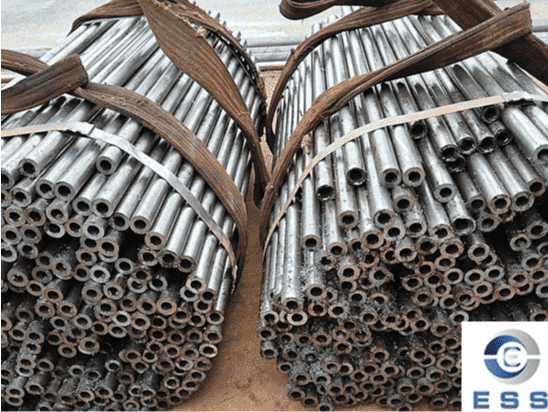When welding seamless stainless steel pipes, in order to reduce the tendency of hot cracking, the weld structure design generally contains a small amount of ferrite, and the control of the ferrite content is mainly realized by the alloy composition. Austenitic stainless steel welds contain more than 3% ferrite, which can effectively avoid solidification cracks, but too much ferrite will adversely affect performance.
1. Effect of ferrite on corrosion performance of stainless steel pipe
The sensitization tendency of the weld metal is lower than that of the base metal. There is ferrite in the weld, its Cr content is higher than that of austenite, and the diffusion rate of Cr in ferrite is much faster than that of austenite. However, M23C6 carbides tend to precipitate at the pitted ferrite-austenite interface. Instead of precipitation at the relatively flat austenite-austenite interface, the rapid diffusion of chromium in ferrite can overcome the problem of chromium deficiency at grain boundaries. These factors greatly limit the sensitization of austenitic stainless steel welds containing ferrite to prevent intergranular corrosion of stainless steel water pipes.
Austenitic stainless steel weld metals containing a small amount of ferrite are corrosion resistant and contain no ferrite in most corrosive environments, corresponding to the parent metal. However, in organic acids, these media selectively attack ferrite. When the ferrite content in the weld metal is greater than 5FN, corrosion will proceed along the ferrite network, resulting in serious damage to the weld.
2. Stainless steel used at high temperature
Ferrite is formed in the austenitic stainless steel weld metal as a secondary phase strengthening. Compared with the base metal and heat-affected zone, the yield strength is significantly improved, while the ductility is comparable. Increasing the ferrite content in the weld metal can significantly increase the strength at room temperature, but the strength at high temperature is slightly improved. Ferrite is a harmful phase of stainless steel water pipes in high temperature environment.
(1) Creep damage of ferrite
The continuous ferrite network in the weld metal promotes rapid creep damage due to earlier crack initiation than the ferrite-austenite interface. At this point the ferrite content should be below 5FN to prevent the formation of a continuous ferrite network
(2) Ferrite embrittlement at 475°C
Fe-Cr alloys with a Cr content of 15% to 70% will produce severely brittle Cr-rich ferrite and iron-rich ferrite when heated to 425°C to 550°C. The ferrite phase of the austenitic stainless steel weld metal is essentially ferrite embedded in the austenite matrix (Cr20-30%, Ni4%-5%). Therefore, if it stays in the temperature range of 425 ℃ ~ 550 ℃ for a long time (about 5000h), the ferrite phase will become brittle, the hardness will increase, and the plasticity and toughness will be damaged. Short-term heating above 550 °C can eliminate this embrittlement phenomenon, but long-term heating will cause σ-phase embrittlement.

3. Low temperature performance
At low temperatures, austenitic stainless steels exhibit good strength, ductility, and toughness; whereas ferritic undergoes a brittle transformation. Therefore, the use of stainless steel water pipes at low temperatures requires a low ferrite content in the weld.
Small amounts of ferrite in austenitic stainless steel welds can reduce low temperature toughness. When the ferrite content in the weld reaches FN=10, the low temperature toughness will decrease by 50%.
The low temperature toughness of stainless steel pipe is not only related to the ferrite content, but also related to the cleanliness of the weld. Tests have shown that the oxygen content of the deposited metal of the basic low-hydrogen electrode is lower than that of the titanium-calcium electrode, and the weld toughness is also better. The oxygen content of the deposited metal in inert gas shielded welding is lower than that of slag shielded welding, and the weld toughness is also better. Ultra-low carbon welding materials have less intergranular precipitation of deposited metal and good welding toughness.
When heat treatment is required after welding or high-temperature service, the ferrite number of weld metal measured before post-weld heat treatment shall not exceed 10FN. When the stainless steel pipe is used in a low temperature environment below -100°C, the low temperature impact test of the weld is carried out in accordance with relevant regulations; when it is used in a low temperature environment below -196°C, the ferrite content of the weld is less than 5FN. When stainless steel pipes are used in non-magnetic or special corrosive environments, they need to be controlled according to design requirements.













 Eastern Steel Manufacturing Co.,Ltd not only improve product production and sales services, but also provide additional value-added services. As long as you need, we can complete your specific needs together.
Eastern Steel Manufacturing Co.,Ltd not only improve product production and sales services, but also provide additional value-added services. As long as you need, we can complete your specific needs together.










